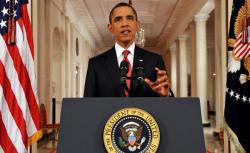Have you heard? Social networking is changing everything! Presidential campaigns are on the hunt for Twitter followers! Michele Bachmann won the Ames straw poll thanks to staffers with iPads! Newt Gingrich is “Facebook savvy”!
There were genuine tech innovations in the political world this year, sure, but there were also a bunch of amusing missteps. Some of them were bizarre, like Newt Gingrich’s failure to buy up newtgingrich.com, leaving it exposed to left-winger re-direct gremlins. Some were the result of overreach. Campaigns and movements drew from online support and activists, but they didn’t always know what to do with them. The result: some memorable failures.
The Twitter debate
It sounded like a bad idea. The execution was worse than anyone imagined. On July 20, six Republican candidates (none of the frontrunners) put their schedules on pause to participate in 140Elect’s Twitter debate. S.E. Cupp, a Daily News columnist and TV pundit, informed the audience that she would be moderating something “historic.” What transpired was like Second Life without the fun fetish objects. Rep. Thaddeus McCotter, in his only debate performance of any kind, set the tone with his opening statement.
.@140townhall Our American Dream is endangered. America’s dismantling. Abroad, our troops fight terrorists & tyrants; Iran goes nuclear; .@140townhall& communist China claims the 21st Century. At home, R 14 mil unemployed; 30+ mil underemployed; inflation up; real wages down. .@140townhall Big Gov’t & Big Biz claim they are bigger than We, the People. And we wonder if we matter anymore. You matter more than ever!
It went on and on like this. Nothing crashed, but the limits of microblogging as a forum for policy discussion were set for all time. There was no second Twitter debate.
Attack Watch
Back in September, Obama for America launched Attack Watch, the 2012 successor to the 2008 campaign’s Fight the Smears. According to the campaign, 100,000 people registered on the site in the first 24 hours to “help stop the attacks on the President before they start.” That was a nice consolation prize for days of ridicule. On Twitter, the #AttackWatch hashtag was immediately commandeered by conservatives like Michelle Malkin and jokesters who noted, for instance, that they “saw someone purposely squeeze the Charmin in the grocery store.” Unlike Fight the Smears, Attack Watch didn’t lead off with any particular mission—it just gives readers a black page of fearsome, looming threats. Who could have designed this and been surprised by the ensuing mockery?
WomenforCain.com
Herman Cain’s presidential campaign went down swinging. After a week of revelations from Ginger White, the sad-eyed Atlanta woman who claimed to have carried on a long affair with Cain, the candidate’s team launched a new site: Women for Cain.
This “online national fellowship of women dedicated to helping elect Herman Cain” included testimonials about Cain from people who know him or just plain like the guy. “Mr. Cain,” wrote Stefani Smirnes, “To me you are the embodiment of the prayers of every faithful believing slave who turned to ALMIGHTY GOD for deliverance from slavery and inequality.” Kim Gash chimed in: “You appear to be a very decent human being that genuinely will help anyone and you also appear to be a true gentleman.”
Bloggers made fun of the clip art—a bunch of women giving thumbs-ups for Cain—so it was struck and replaced by an image of Cain and his long-suffering wife. By that point, it was too late—Cain had suspended his campaign.

AFP/Getty Images.
Tweet your congressman
When the debt fight reached its final, desperate weeks, President Obama called on people of good faith to speak out. “Make a phone call,” he said. “Send an email. Tweet. Keep the pressure on Washington.” He was serious. The typically bland @BarackObama Twitter account, started machine-gunning the Twitter accounts of Republican members of Congress. “If you live in Arizona, ask @SenJohnKyl and @SenJohnMcCain to support a bipartisan compromise to the debt crisis.”
Did it totally fail? Well, the debt crisis ended. And the compromise was bipartisan, meaning that no one liked it or took it seriously. But according to Mashable, @BarackObama lost around 37,000 followers during this period of aggressive tweeting. The administration has not since repeated the trick.
We Are the 53%
This was the year of the Tumblr. After a meme began on Twitter or 4Chan or TV, a Tumblr would spring up immediately to collect variations of the meme. They burned brightly, they faded fast; (remember Newt Gingrich Judges You?). One of them actually mattered. We Are the 99 Percent, which launched almost simultaneously with Occupy Wall Street, collected scrawled-out testimonials from people who said they were suffering in the Great Recession.
The next iteration: We Are the 53%, Red State blogger Erick Erickson’s Tumblr about people who paid income taxes and were proud of it. The tagline: “Those of us who pay for those of you who whine about all of that … or that … or whatever.”
It was funny, buzzy, and totally misguided. Parodying the Occupiers only reinforced their message—anyone who wrote about the conservative campaign had to write about the 99’ers who’d inspired them. The Tumblr quickly ran out of steam. In December, it was hardly updated at all.

AFP/Getty Images.
Mike check
After settling in at Zuccotti Park, the fathers of the Occupy Wall Street movement had a problem: If they wanted to stay in the park, they couldn’t use any kind of sound amplification tech. That meant no megaphones and no sound trucks.
So how to be heard above the din of drummers? Protesters borrowed a technique from other low-fi organizers. When someone wanted to speak, she would yell, “Mike check!” The people nearby would repeat it, and the speaker would give a short statement before passing the “mike.” Funny enough, this worked. Protesters (well, most of them) got to be tighter public speakers, avoiding the rambling that can so easily drag down a rally. The “people’s microphone” went nationwide, with Occupiers using it to shout down President Obama, Newt Gingrich, and Chris Christie. At long last in 2011, this was a technical failure that actually got results.